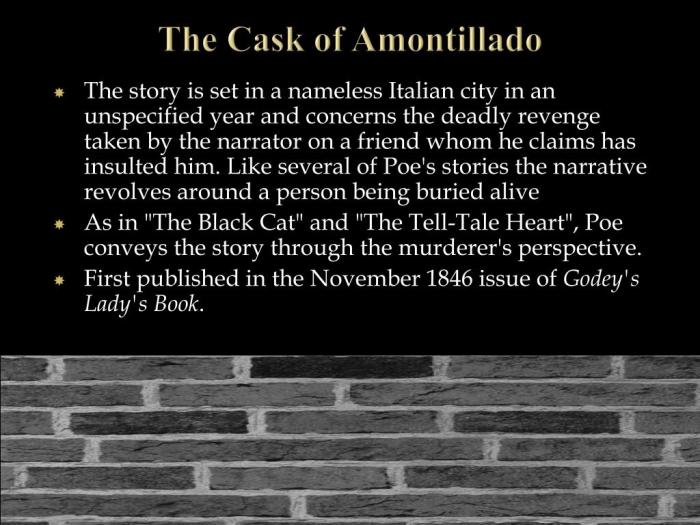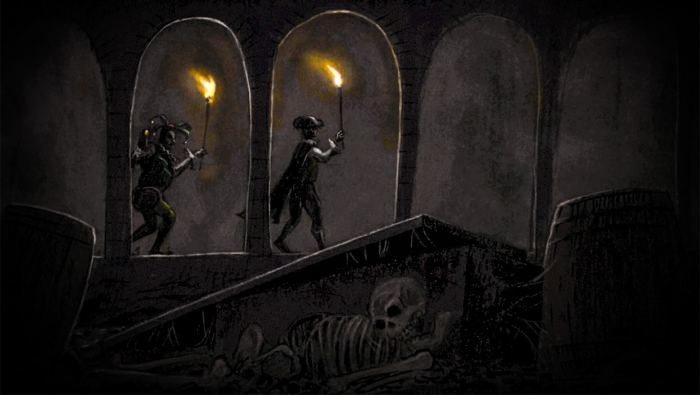The cask of amontillado commonlit – Edgar Allan Poe’s “The Cask of Amontillado” is a chilling masterpiece that captivates readers with its exploration of revenge, pride, and the nature of evil. Set in a time of masked balls and hidden identities, the story follows the vengeful Montresor as he lures his unsuspecting victim, Fortunato, into a subterranean labyrinth.
With its use of foreshadowing, irony, and symbolism, Poe creates an atmosphere of suspense and dread that lingers long after the final page is turned. Through the characters of Montresor and Fortunato, he delves into the complexities of human nature, revealing the darkness that can lurk beneath the surface.
Introduction
Edgar Allan Poe’s “The Cask of Amontillado” is a classic tale of revenge and horror that explores the dark recesses of the human psyche. Set in the catacombs of an ancient Italian city, the story follows the narrator, Montresor, as he lures his enemy, Fortunato, to a gruesome fate.
Literary Devices and Techniques

Poe employs various literary devices to create a haunting and suspenseful atmosphere. Foreshadowing is used throughout the story, with subtle hints of the impending doom that awaits Fortunato. Irony plays a significant role, as the narrator’s calm and calculated demeanor contrasts sharply with the terror he inflicts upon his victim.
The story also features rich symbolism. The catacombs represent the depths of Montresor’s hatred and the darkness that consumes his soul. The cask of Amontillado symbolizes the entrapment and inevitable demise of Fortunato.
Character Analysis

Montresor
Montresor is a complex and enigmatic character. He is consumed by a desire for revenge against Fortunato, whom he believes has wronged him. Montresor is meticulous in his planning and execution of his revenge, showing no remorse or empathy for his victim.
Fortunato, The cask of amontillado commonlit
Fortunato is a wealthy and pompous aristocrat. He is oblivious to Montresor’s true intentions and falls prey to his elaborate scheme. Fortunato’s arrogance and self-indulgence ultimately lead to his downfall.
Themes and Symbolism
Revenge
Revenge is a central theme in “The Cask of Amontillado.” Montresor’s desire for revenge drives his actions throughout the story. The story explores the destructive nature of revenge and the moral implications of taking justice into one’s own hands.
Pride
Pride is another important theme. Fortunato’s arrogance and pride lead him to underestimate Montresor’s true nature. The story suggests that excessive pride can be a dangerous flaw.
The Nature of Evil
The story also delves into the nature of evil. Montresor is a cold and calculating villain who takes pleasure in the suffering of others. The story raises questions about the origins of evil and the potential for darkness within the human soul.
Historical and Cultural Context: The Cask Of Amontillado Commonlit

The story is set in the catacombs of an ancient Italian city, which provides a backdrop of mystery and decay. The setting reflects the themes of death and revenge that permeate the story.
The story was written during the 19th century, a time of great social and political change. The story’s exploration of themes such as revenge and justice may have resonated with readers during this period.
Artistic and Cultural Adaptations
“The Cask of Amontillado” has been adapted into various artistic and cultural forms, including film, theater, and music.
Notable adaptations include a 1968 film directed by Roger Corman and a 1995 opera composed by Philip Glass. These adaptations have helped to bring the story to a wider audience and explore its themes and characters in new ways.
Essential Questionnaire
What is the significance of the setting in “The Cask of Amontillado”?
The setting of a dark and labyrinthine cellar adds to the atmosphere of suspense and claustrophobia, symbolizing the entrapment of Fortunato and the darkness within Montresor’s soul.
How does irony contribute to the story’s impact?
Poe uses irony to create a sense of dramatic tension and highlight the characters’ flaws. For example, Fortunato’s pride in his connoisseurship leads to his downfall.
What is the symbolic meaning of the cask of Amontillado?
The cask represents both the physical and metaphorical trap that Montresor sets for Fortunato. It also symbolizes the secret and hidden aspects of human nature.